AEG-Electrolux ESF6221 User Manual
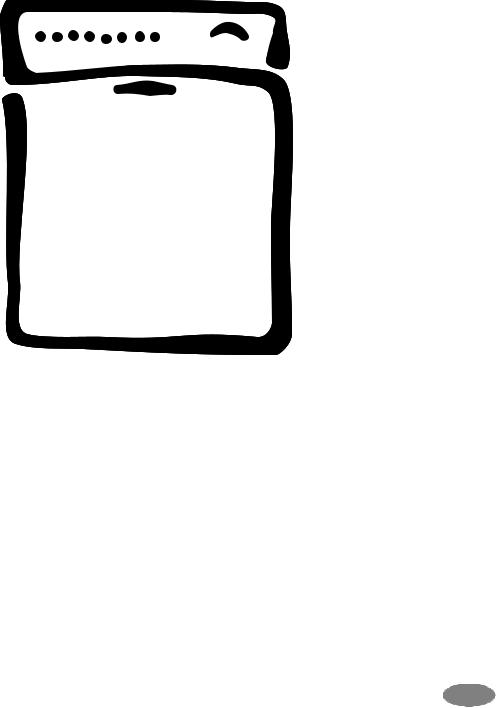
D i s h w a s h e r
User Instructions
ESF 6221
ANC 822 961 115 - 00 - 0703
EN
Dear customer,
Please read these user instructions carefully. |
3 |
Your dishwasher is fitted with the new |
|
Above all please observe the safety instructions on |
"PULSE WASH" wash system. |
||
the first few pages ofthese user instructions! Please |
|
With this wash system, the motor speed |
|
keep these user instructions for later reference. Pass |
|
and spray pressure are varied during the |
|
them on to any subsequent owner of the appliance. |
|
wash programme to improve the cleaning |
|
1 |
The warning triangle and/or specific words |
|
of the dishes. It is for this reason that the |
|
noise level changes during the wash pro- |
||
(Warning!, Caution!, Important!) are used |
|
||
to highlight instructions that are important for |
gramme. |
|
|
your safety or for the function of the appli- |
|
ance. It is imperative that these instructions |
|
are observed. |
|
This symbol or numbered instruction steps |
|
lead you step for step through the operation |
|
of the appliance. |
|
3Next to this symbol you receive additional information and practical tips on using the appliance.
2Tips and instructions for the economical and environmentally conscious use of the appliance are marked with a clover leaf.
In the event of a malfunction, these operating instructions contain information on how to rectify faults yourself, see the "What to do, if..." section.
If these instructions are insufficient, please contact your nearest customer service centre.
In the case of technical problems, our customer service organisation is available to provide you with assistance at any time (you will find addresses and telephone numbers in the "Customer Service Centres" section).
In this respect please read the "Service" note on the rear of these user instructions.
2
Contents
Safety Instructions . . . . . . . . . . . . . . . . . . . . . . . . . . . . . . . . . . . . . . . . . . . . . . . . . . . . . . . . . . . . . . . . . . . . . . 4
Dishwasher door safety catch . . . . . . . . . . . . . . . . . . . . . . . . . . . . . . . . . . . . . . . . . . . . . . . . . . . . . . . . . . . . . . 5
Disposal . . . . . . . . . . . . . . . . . . . . . . . . . . . . . . . . . . . . . . . . . . . . . . . . . . . . . . . . . . . . . . . . . . . . . . . . . . . . . . 6
Economical and Ecological Dishwashing . . . . . . . . . . . . . . . . . . . . . . . . . . . . . . . . . . . . . . . . . . . . . . . . . . . 6
Appliance Features and Control Panel . . . . . . . . . . . . . . . . . . . . . . . . . . . . . . . . . . . . . . . . . . . . . . . . . . . . . 7
Control Panel . . . . . . . . . . . . . . . . . . . . . . . . . . . . . . . . . . . . . . . . . . . . . . . . . . . . . . . . . . . . . . . . . . . . . . . . . . . 8
Prior to using for the first time . . . . . . . . . . . . . . . . . . . . . . . . . . . . . . . . . . . . . . . . . . . . . . . . . . . . . . . . . . . . 8
Adjust the water softener . . . . . . . . . . . . . . . . . . . . . . . . . . . . . . . . . . . . . . . . . . . . . . . . . . . . . . . . . . . . . . . . . . 9 Filling with Special Salt for the Water Softener . . . . . . . . . . . . . . . . . . . . . . . . . . . . . . . . . . . . . . . . . . . . . . . . 11 Filling with Rinse Aid . . . . . . . . . . . . . . . . . . . . . . . . . . . . . . . . . . . . . . . . . . . . . . . . . . . . . . . . . . . . . . . . . . . . 12 Adjusting Rinse Aid Dosing . . . . . . . . . . . . . . . . . . . . . . . . . . . . . . . . . . . . . . . . . . . . . . . . . . . . . . . . . . . . . 13
In Daily Use . . . . . . . . . . . . . . . . . . . . . . . . . . . . . . . . . . . . . . . . . . . . . . . . . . . . . . . . . . . . . . . . . . . . . . . . . . . |
14 |
Loading cutlery and dishes . . . . . . . . . . . . . . . . . . . . . . . . . . . . . . . . . . . . . . . . . . . . . . . . . . . . . . . . . . . . . . . |
14 |
Loading Cutlery . . . . . . . . . . . . . . . . . . . . . . . . . . . . . . . . . . . . . . . . . . . . . . . . . . . . . . . . . . . . . . . . . . . . . . |
15 |
Loading Pans, Frying Pans and Large Plates . . . . . . . . . . . . . . . . . . . . . . . . . . . . . . . . . . . . . . . . . . . . . . . |
16 |
Loading Cups, Glasses and Coffee Services . . . . . . . . . . . . . . . . . . . . . . . . . . . . . . . . . . . . . . . . . . . . . . . |
17 |
Adjusting the Height of the Upper Basket . . . . . . . . . . . . . . . . . . . . . . . . . . . . . . . . . . . . . . . . . . . . . . . . . . |
17 |
Filling with Detergent . . . . . . . . . . . . . . . . . . . . . . . . . . . . . . . . . . . . . . . . . . . . . . . . . . . . . . . . . . . . . . . . . . . . |
18 |
Use of "3 in 1"/ Combi Detergent Tablets . . . . . . . . . . . . . . . . . . . . . . . . . . . . . . . . . . . . . . . . . . . . . . . . . . |
19 |
Concentrated Detergent . . . . . . . . . . . . . . . . . . . . . . . . . . . . . . . . . . . . . . . . . . . . . . . . . . . . . . . . . . . . . . . |
19 |
Selecting the Wash Programme (Programme Table) . . . . . . . . . . . . . . . . . . . . . . . . . . . . . . . . . . . . . . . . . . . |
20 |
Start the wash program . . . . . . . . . . . . . . . . . . . . . . . . . . . . . . . . . . . . . . . . . . . . . . . . . . . . . . . . . . . . . . . . . . |
21 |
Interrupting or ending the wash program . . . . . . . . . . . . . . . . . . . . . . . . . . . . . . . . . . . . . . . . . . . . . . . . . . |
21 |
Pause function . . . . . . . . . . . . . . . . . . . . . . . . . . . . . . . . . . . . . . . . . . . . . . . . . . . . . . . . . . . . . . . . . . . . . . |
21 |
Load Sensing . . . . . . . . . . . . . . . . . . . . . . . . . . . . . . . . . . . . . . . . . . . . . . . . . . . . . . . . . . . . . . . . . . . . . . . |
21 |
Switching Off the Dishwasher . . . . . . . . . . . . . . . . . . . . . . . . . . . . . . . . . . . . . . . . . . . . . . . . . . . . . . . . . . . . . |
21 |
Care and Cleaning . . . . . . . . . . . . . . . . . . . . . . . . . . . . . . . . . . . . . . . . . . . . . . . . . . . . . . . . . . . . . . . . . . . . . 22
Cleaning the Filter . . . . . . . . . . . . . . . . . . . . . . . . . . . . . . . . . . . . . . . . . . . . . . . . . . . . . . . . . . . . . . . . . . . . . . 22
What to do, when ... . . . . . . . . . . . . . . . . . . . . . . . . . . . . . . . . . . . . . . . . . . . . . . . . . . . . . . . . . . . . . . . . . . . . 23
...Fault warnings are displayed. . . . . . . . . . . . . . . . . . . . . . . . . . . . . . . . . . . . . . . . . . . . . . . . . . . . . . . . . . . . . 23
...there are problems operating the dishwasher. . . . . . . . . . . . . . . . . . . . . . . . . . . . . . . . . . . . . . . . . . . . . . . . 24
...the wash results are unsatisfactory. . . . . . . . . . . . . . . . . . . . . . . . . . . . . . . . . . . . . . . . . . . . . . . . . . . . . . . . 24
Technical Data . . . . . . . . . . . . . . . . . . . . . . . . . . . . . . . . . . . . . . . . . . . . . . . . . . . . . . . . . . . . . . . . . . . . . . . . 25
Notes for Test Institutes . . . . . . . . . . . . . . . . . . . . . . . . . . . . . . . . . . . . . . . . . . . . . . . . . . . . . . . . . . . . . . . . 26
Installation and Connection Instructions . . . . . . . . . . . . . . . . . . . . . . . . . . . . . . . . . . . . . . . . . . . . . . . . . . . 28
Installing the Dishwasher . . . . . . . . . . . . . . . . . . . . . . . . . . . . . . . . . . . . . . . . . . . . . . . . . . . . . . . . . . . . . . . 28
Dishwashers That Can Be Integrated . . . . . . . . . . . . . . . . . . . . . . . . . . . . . . . . . . . . . . . . . . . . . . . . . . . . . 28
Built-In Dishwasher . . . . . . . . . . . . . . . . . . . . . . . . . . . . . . . . . . . . . . . . . . . . . . . . . . . . . . . . . . . . . . . . . . . 29
Free-Standing Appliances . . . . . . . . . . . . . . . . . . . . . . . . . . . . . . . . . . . . . . . . . . . . . . . . . . . . . . . . . . . . . . 29
Connecting the Dishwasher . . . . . . . . . . . . . . . . . . . . . . . . . . . . . . . . . . . . . . . . . . . . . . . . . . . . . . . . . . . . . 30
Water Connection . . . . . . . . . . . . . . . . . . . . . . . . . . . . . . . . . . . . . . . . . . . . . . . . . . . . . . . . . . . . . . . . . . . . . . 30 Permitted water pressure . . . . . . . . . . . . . . . . . . . . . . . . . . . . . . . . . . . . . . . . . . . . . . . . . . . . . . . . . . . . . . 30 Connect the inlet hose . . . . . . . . . . . . . . . . . . . . . . . . . . . . . . . . . . . . . . . . . . . . . . . . . . . . . . . . . . . . . . . . 30 Water drain . . . . . . . . . . . . . . . . . . . . . . . . . . . . . . . . . . . . . . . . . . . . . . . . . . . . . . . . . . . . . . . . . . . . . . . . . 32 Leak Prevention System . . . . . . . . . . . . . . . . . . . . . . . . . . . . . . . . . . . . . . . . . . . . . . . . . . . . . . . . . . . . . . . 33
Electrical connection . . . . . . . . . . . . . . . . . . . . . . . . . . . . . . . . . . . . . . . . . . . . . . . . . . . . . . . . . . . . . . . . . . . . 33 Connections . . . . . . . . . . . . . . . . . . . . . . . . . . . . . . . . . . . . . . . . . . . . . . . . . . . . . . . . . . . . . . . . . . . . . . . . . . . 34
Service . . . . . . . . . . . . . . . . . . . . . . . . . . . . . . . . . . . . . . . . . . . . . . . . . . . . . . . . . . . . . . . . . . . . . . . . . . . . . . . 35
3
1 Safety Instructions
The safety aspects of ELECTROLUX electrical appliances comply with accepted technical standards and the German Appliance Safety Law. Nevertheless, as a manufacturer we consider it our obligation to make you aware of the following safety information:
Installation, Connection and Placing into Operation
•The dishwasher may only be transported upright.
•Check the dishwasher for transport damage. Do not in any circumstances connect an appliance that is damaged. In the case of damage, please contact your supplier.
•Prior to placing the appliance in operation, ensure that the nominal voltage and type of supply on the rating plate match that of the supply where the appliance is to be installed. The fuse rating is also to be found on the rating plate.
•For information on how to correctly install and connect up your dishwasher, please read the “Installation“ section. Multiway plugs / connectors and extension cables must not be used. This could constitute a safety hazard.
Child Safety
•Children often do not recognise the hazards associated with the use of electrical appliances. It is therefore important that you ensure children are adequately supervised and that you do not allow children to play with the dishwasher – there is a risk that children can shut themselves inside the appliance (risk of suffocation!).
•Packaging materials (e.g. films, styrofoam) can be dangerous for children. Risk of suffocation! Keep packaging away from children.
•Detergents can cause burns to the eyes, mouth, and throat, or even cause choking! Please observe the manufacturer's safety instructions for cleaners and detergents.
•The water in your dishwasher is not suitable for drinking. If there are still remnants of detergent in the appliance, there is a risk of burns!
•When disposing of the dishwasher: unplug from the mains, cut off and dispose of the mains cable. Break the door lock so that the door no longer shuts.
General Safety
•Repairs to the dishwasher are only to be carried out by qualified service engineers. Improper repairs can give rise to significant hazards for the user. If your appliance needs repairing, please contact customer service or your dealer.
•Never place the dishwasher in operation if the mains cable, water inlet or drain hose is damaged; or the control panel, work top or plinth area is damaged such that the inside of the appliance is freely accessible.
•If the mains lead is damaged, or is to be replaced for a longer lead, the cable (obtainable from ELECTROLUX customer service) must be changed by a service engineer authorised by ELECTROLUX.
•Never unplug the appliance by pulling on the cable, always pull the plug.
•Additions or modifications to the dishwasher are not permitted for safety reasons.
•Ensure that the door of the dishwasher is always closed when it is not being loaded or unloaded. In this way you will avoid anybody tripping over the open door and hurting themselves.
•Sharp knives and items of cutlery with sharp edges must be placed in the cutlery tray or in the upper rack.
Correct Use
•Only wash household dishes using the dishwasher. If the appliance is used for other purposes, or is used incorrectly, the manufacturer cannot accept any liability for any damage caused.
•Prior to use, ensure that the manufacturers of the special salt, detergent, and rinse aid employed specifically permit the usage of their products in household dishwashers.
•Do not put any solvents in the dishwasher. There is a risk of an explosion!
•The anti-flood system provides dependable protection against damage due to leaks. For this system to function correctly, the following preconditions must be met:
–The appliance must remain connected to the mains even when it is switched off.
–The dishwasher must be correctly installed.
–Always shut off the water supply at the tap when the dishwasher is not to be used for longer periods, e.g. when you are away on holiday.
•Do not sit or stand on the open door, the appliance may tip over.
•In the event of a fault, first close the tap, then switch off the appliance and unplug it from the mains. If the appliance is permanently wired to the mains: switch off the fuse(s) or unscrew them.
4
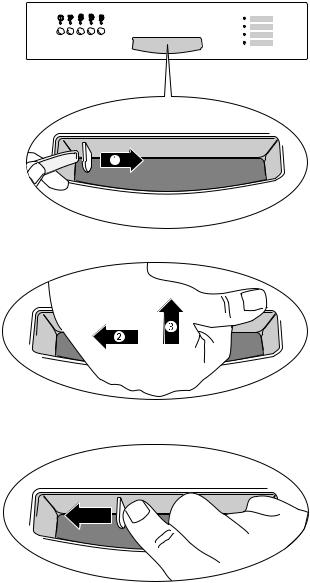
Dishwasher door safety catch
The dishwasher has a door safety catch.
This safety catch prevents children opening the dishwasher door by mistake.
You can set the door safety catch as follows:
1.There is a catch on the left inside the door handle
(1). To ensure that the dishwasher door cannot be opened unintentionally, push this catch across to the right (eg. with the handle of a spoon).
2.To open the dishwasher door once the safety catch has been set you must
–first move the door handle to the left (2) until you feel slight resistance.
–then push the door handle upwards (3) / forwards.
3.To cancel the dishwasher door safety catch, push the catch completely across to the left with your finger.
5
2 Disposal
Disposing of the Packaging Material
Dispose of the dishwasher packaging material correctly. All the packaging materials used are harmless to the environment and can be recycled.
•Plastic parts are marked with standard interna-
tional abbreviations:
– |
>PE< |
for polyethylene, e.g. sheet wrapping |
|
material |
|
– |
>PS< |
for polystyrene, e.g. padding mate- |
rial (always CFC-free)
–>POM< for polyoxymethylene, e.g. plastic clips
•Cardboard packaging is manufactured from recycled paper and should be deposited in the waste paper collection for recycling.
Disposal of old appliances
As and when you cease to use your dishwasher, please take it to a recycling centre or to your dealer who will, for a small contribution to the costs, dispose of it for you.
2Economical and Ecological Dishwashing
•Only connect the dishwasher to the hot water supply if your hot water is not electrically heated.
•Ensure that the water softener is correctly adjusted.
•Do not pre-rinse dishes under running water.
•When you wash a small load, the load sensor calculates the amount of water necessary and shortens the programme. It is more economical to always wash with a full load.
•Select the wash programme to suit the nature and degree of the soiling on the dishes.
•Do not use more detergent, special salt or rinse aid than is recommended in these operating instructions and by the manufacturer of the respective product.
6
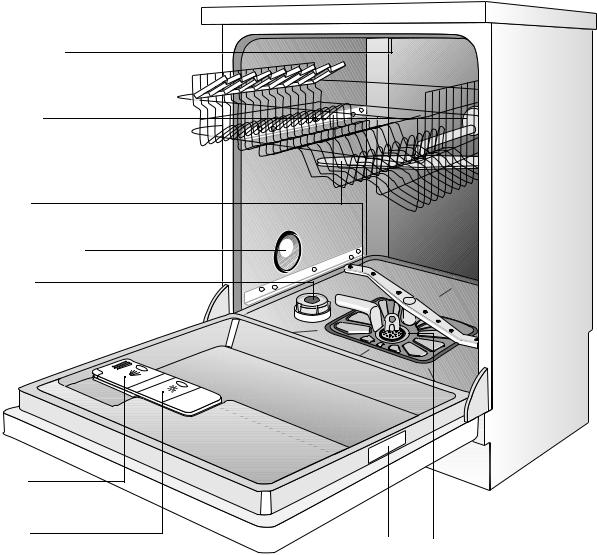
Appliance Features and Control Panel
Top Spray Nozzle |
|
|
Rubber Seal for |
|
|
Connecting the |
|
|
Water Feed to |
|
|
the Spray Arm |
|
|
Spray Arms |
|
|
Water hardness switch |
|
|
Container for |
|
|
Special Salt |
|
|
Container for |
|
|
Detergent |
|
|
Container for |
|
|
Rinse Aid |
Rating Plate |
Filters |
7
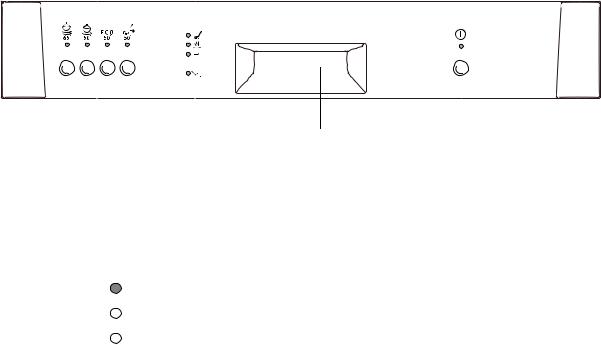
Control Panel
Water softener |
Function |
Multidisplay |
||||||
button |
button |
|||||||
|
|
|
|
|
|
|
|
|
|
|
|
|
|
|
|
|
|
|
|
|
|
|
|
|
|
|
|
|
|
|
|
|
|
|
|
|
|
|
|
|
|
|
|
|
|
|
|
|
Wash program |
|
buttons |
|
|
|
|
|
|||
|
Control |
indicator |
Door handle |
ON / OFF button |
||||||
Water softener and function button: In addition to the indicated wash program, the dishwasher water softener can be set using a combination of these buttons.
The 3 lights on the |
|
: Top light |
|
|
|||
multidisplay |
|
: Middle light |
|
|
|||
can display : |
|
||
• the |
current |
|
: Bottom light |
|
|||
stage |
of the |
|
|
|
|
||
wash |
program |
|
|
selected.
•which fault has occurred in the dishwasher.
Control indicator has the following significance:
t |
Refill with salt |
|
|
3The control indicator never lights up while a wash program is running.
Prior to using for the first time
Prior to using for the first time, remove all the clips with which the dish racks are secured for transport. Then perform the following steps:
1.Adjust the water softener
2.Filling with Special Salt for the Water Softener
3.Filling with Rinse Aid
3Special salt and rinse aid must not be added if you use 3-in-1 detergent tablets.
8
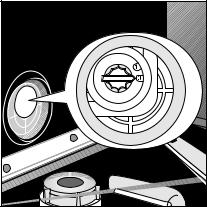
Adjust the water softener
To prevent limescale deposits on dishes and in the dishwasher, the dishes must be washed with soft water, i.e. water with low lime content. For this reason the dishwasher is fitted with a water softener in which tap water from a hardness of 4 °d (German degree) is softened with the aid of special salt.
3Your local water authority can advise you on the hardness of the water in your area.
The water softener can be set manually using the water hardness switch; it can also be set electronically using the buttons on the control panel.
|
Water hardness |
|
Hardness setting |
Number of |
|||
|
|
|
|
|
|
|
|
in °d1) |
|
in mmol/l2) |
Range |
manual |
electronic |
flashes |
|
|
|
||||||
|
|
|
|
|
|
|
|
41 - 50 |
|
7.3 – 9.0 |
|
IV |
1 |
5 |
5 |
|
|
|
|
|
|
|
|
30 - 40 |
|
5.3 – 7.2 |
|
IV |
4 |
4 |
|
|
|
|
|||||
|
|
|
|
|
|
|
|
19 - 29 |
|
3.3 – 5.2 |
|
III/IV |
|
3* |
3 |
|
|
|
|
|
|
|
|
4 - 18 |
|
0.7 – 3.2 |
|
I/II/III |
0* |
2 |
2 |
|
|
|
|
|
|
|
|
under 4 |
|
under 0.7 |
|
I |
|
1 |
1 |
|
|
|
no salt necessary |
||||
|
|
|
|
|
|
|
|
|
|
|
|
|
|
|
|
1)(°d) German degrees, a measure of water hardness 2)(ppm), parts per million
*factory setting
Adjust the water softener to the water hardness settings for your area as shown in the table:
1It is only possible to adjust the water hardness setting when no program is running. If you have inadvertently started a program (a LED stays on permanently), then the program must be cancelled by pressing the appropriate button.
1.The dishwasher must be switched off.
2.Manual setting:
Open the door of the dishwasher.
3.Remove the lower rack from the dishwasher.
4.Turn the water hardness switch to 0 or 1.
5.Re-position the lower rack.
6.Electronic setting:
Press the water softener button and the function button simultaneously and hold them down.
7.In addition press the ON/OFF button.
8.The LED indicators for the water softener and function buttons flash.
9.Press the softener button again.
–At first the LED indicator for the water softener button will light up continuously for 5 seconds and then begin to flash.
–The number of flashes corresponds to the hardness setting.
–The sequence of flashes is repeated several times after a 5 second pause.
10.Each time you press the water-softener button the hardness setting will go up by 1.
(Exception: Hardness setting 1 follows hardness setting 5).
9
–If the hardness setting is changed, the LED indicator for the softener button lights up and stays on for 5 seconds as confirmation and then begins to flash again.
–The number of flashes corresponds to the new hardness setting.
–The sequence of flashes is repeated several times after a 5 second pause.
11.Once the hardness setting is correctly adjusted, press the ON/OFF button.
The hardness setting is then stored.
10
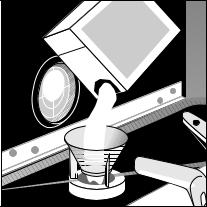
Filling with Special Salt for the Water Softener
1Use only special salt for dishwashers. Never fill the salt container with any another type of salt (e.g. culinary salt) or dishwasher detergent. This would irreparably damage the water softener.
Prior to filling with salt, please check each time that you really do have a packet of special salt in your hand.
Fill with special salt:
•Prior to using the dishwasher for the first time
•When the SALT indicator t on the control panel is illuminated.
3If the water hardness in your area is less than 4 °d, you do not need to use special salt.
1.Open the door, remove the lower rack.
2.Undo the lid on the salt container by turning it anticlockwise.
3.Only when using for the first time: fill the salt container with water.
4.Place the funnel supplied on the container opening.
Fill the container with special salt through the funnel; the capacity of the container is approx. 1.0- 1.5 kg depending on the grain size. Do not overfill the salt container with special salt.
3The water expelled by filling the salt container with special salt runs out of the salt container onto the base of the washing compartment. This is not a cause for concern, the water will be pumped out at the start of the next wash programme.
5.Clean any salt remnants on the container opening.
6.Turn the lid clockwise to the stop, otherwise special salt will leak into the wash water, this could lead to poor wash results. To avoid this run a rinse program after filling the salt container with special salt. This will wash away salt water and any salt crystals that have been spilt.
3Depending on the size of the salt grains, it can take several hours for the salt to dissolve
in the water and the special salt indicator tto extinguish.
The setting of the water softener and thus the consumption of salt are dependent on the hardness of the local water.
SALE |
SALT |
SALZ |
SEL |
11
